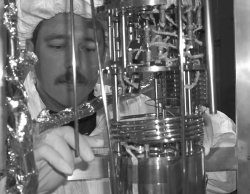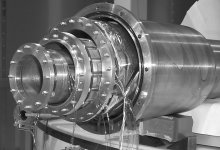 |
|
A Cryostat on the Edge Mike Perricone
“Even for a place like Fermilab, this cryo system is way out at the edge,” said CDMS Project Manager Roger Dixon. “Getting that much mass to that cold a temperature is quite a challenge. If you say you’re running at 25 milli-Kelvin, even some cryogenics people will say, ‘How do you do that?’ Paul Brink (senior research associate from Stanford), and Rich Schmitt, Bruce Lambin and Bryan Johnson of Fermilab were excited by that challenge.”
The experiment requires an extremely low radioactivity background, leading to a cryostat made entirely of high-purity copper using electron-beam welding. The extremely tight tolerances were checked on a coordinate measuring machine. The copper was acid-treated to remove any surface contamination, then cleaned again at the Soudan mine site with alcohol and lint-free wipes. The cryostat was assembled in a Class-10,000 clean room (10,000 particles per cubic foot) that was built in the experiment hall—a mine shaft a half-mile below ground, adjacent to the MINOS (Main Injector Neutrino Oscillation Search) detector chamber. The clean room is regularly policed with HEPA vacuum cleaners, and has a particle counter running continuously.
“When we get this thing fired up,” Lambin said, “it should be the coldest spot in Minnesota, and that’s saying something.”
The cryo system could be ready for the detectors to arrive from Stanford as early as May. That would cap off more than a year of regular ten-hour, 550-mile drives from Fermilab; two- to three-week stays in an apartment in Minnesota; and shifts that begin when the elevator brings you down and end when the elevator returns to take you to the surface.
“We have to bring everything with us,” Lambin said. “We can’t run out to a hardware store. There’s no McDonald’s for lunch. On the other hand, there’s something nice about seeing more deer than cars when you’re driving to work.”
|
| last modified 1/18/2002 email Fermilab |
FRLsDFx9eyfrPXgV
 The ultra-sensitivity of the germanium and silicon crystal detectors for the Cryogenic Dark Matter Search depends on ultra-cold operating temperatures—25 milli-Kelvin (25 thousandths of a degree above absolute zero). Most cryogenic apparatus at Fermilab operates at approximately 4.5 Kelvin.
The ultra-sensitivity of the germanium and silicon crystal detectors for the Cryogenic Dark Matter Search depends on ultra-cold operating temperatures—25 milli-Kelvin (25 thousandths of a degree above absolute zero). Most cryogenic apparatus at Fermilab operates at approximately 4.5 Kelvin.
 The cryostat consists of six nested layers (“cans”). The outermost layer is at room temperature, and each succeeding layer is colder, with the innermost and coldest can housing the detector. Refrigeration is produced by a dilution unit from Oxford Instruments in England, using liquid nitrogen and liquid helium for precooling. The refrigerant is a mixture of Helium-3 and Helium-4, designed to reach 10 milli-Kelvin. The refrigerator also has six layers, each connected to the cryostat.
The cryostat consists of six nested layers (“cans”). The outermost layer is at room temperature, and each succeeding layer is colder, with the innermost and coldest can housing the detector. Refrigeration is produced by a dilution unit from Oxford Instruments in England, using liquid nitrogen and liquid helium for precooling. The refrigerant is a mixture of Helium-3 and Helium-4, designed to reach 10 milli-Kelvin. The refrigerator also has six layers, each connected to the cryostat.
 “The trickiest part is keeping out contaminants,” Schmitt explained. “We have copper parts that are so close, they are actually touching at room temperature. Then they separate due to thermal contraction. If there is still contact, that will bring in enough heat to spoil the operation. If anything is misaligned, we have to take it apart and reassemble it.”
“The trickiest part is keeping out contaminants,” Schmitt explained. “We have copper parts that are so close, they are actually touching at room temperature. Then they separate due to thermal contraction. If there is still contact, that will bring in enough heat to spoil the operation. If anything is misaligned, we have to take it apart and reassemble it.”